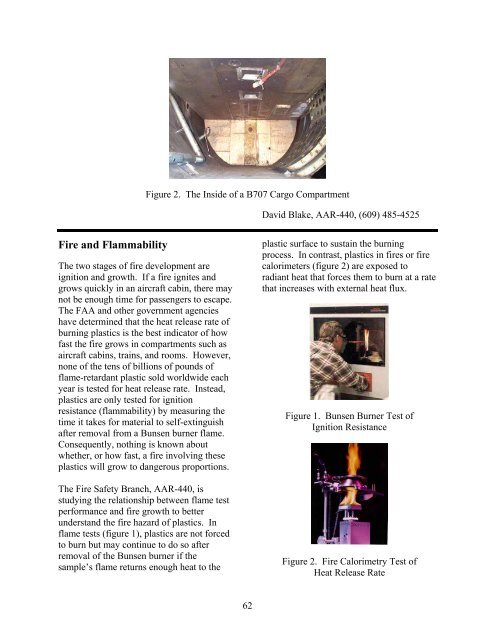AAR-400 Highlights 2002 - Fire Safety Branch - FAA
AAR-400 Highlights 2002 - Fire Safety Branch - FAA
AAR-400 Highlights 2002 - Fire Safety Branch - FAA
You also want an ePaper? Increase the reach of your titles
YUMPU automatically turns print PDFs into web optimized ePapers that Google loves.
<strong>Fire</strong> and Flammability<br />
Figure 2. The Inside<br />
of a B707<br />
Cargo Compartment<br />
The two stages of fire development are<br />
ignition and growth. If a fire ignites and<br />
grows quickly in an aircraft cabin, there may<br />
not be enough time for passengers to escape.<br />
The <strong>FAA</strong> and other government agencies<br />
have determined that the heat release rate of<br />
burning plastics is the best indicator of how<br />
fast the fire grows in compartments such as<br />
aircraft cabins, trains,<br />
and rooms. However,<br />
none<br />
of the tens of<br />
billions of pounds of<br />
flame-retardant plastic sold worldwide each<br />
year is tested for heat release rate. Instead,<br />
plastics are only tested for ignition<br />
resistance (flammability) by measuring the<br />
time it takes for material to self-extinguish<br />
after removal from a Bunsen burner flame.<br />
Consequently, nothing is known about<br />
whether, or how fast, a fire involving these<br />
plastics will grow to dangerous proportions.<br />
The <strong>Fire</strong> <strong>Safety</strong> <strong>Branch</strong>, <strong>AAR</strong>-440, is<br />
studying the relationship between flame test<br />
performance and fire growth to better<br />
understand the fire hazard of plastics. In<br />
flame tests (figure 1), plastics are not forced<br />
to burn but may continue to do so after<br />
removal of the Bunsen burner if the<br />
sample’s flame returns enough heat to the<br />
62<br />
David Blake, <strong>AAR</strong>-440, (609) 485-4525<br />
plastic surface to sustain the burning<br />
process. In contrast, plastics in fires or fire<br />
calorimeters (figure 2) are exposed to<br />
radiant heat that forces them to burn at a rate<br />
that increases with external heat flux.<br />
Figure 1. Bunsen Burner Test of<br />
Ignition Resistance<br />
Figure 2. <strong>Fire</strong> Calorimetry Test of<br />
Heat Release Rate
















